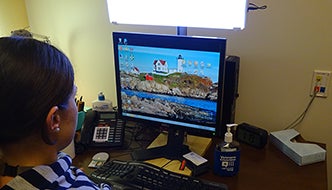In 2017, the Lighting Research Center (LRC) at Rensselaer published a groundbreaking study showing that office workers who receive a robust dose of circadian-effective light experience better sleep, and lower levels of depression and stress, than those who spend their days in dim or low light levels. The team of LRC researchers, led by Mariana Figueiro and sponsored by the U.S. General Services Administration, measured existing light levels for 109 participants at five federal office buildings designed to maximize daylight availability indoors. The research team found that even in open offices with many large windows, office workers were not receiving enough light to stimulate their circadian system during the day, due to factors such as season, cloud cover, desk orientation, and window shade position.
In response to these findings, the LRC team theorized that supplemental electric lighting could be used to ensure that office workers receive enough light during the day—and they put their theory to the test in this new study, installing circadian-effective lighting for 68 participants at two additional U.S. federal government office sites and two U.S. embassies, and evaluating whether the lighting intervention would reduce sleepiness and increase alertness, vitality, and energy. The U.S. embassy sites, in Reykjavík, Iceland, and Riga, Latvia, near the Arctic, experience a dramatic reduction in daylight hours and extended darkness in winter. The federal government office sites, the White River Junction VA Medical Center in Vermont, and the Turner-Fairbank Highway Research Center, near Washington, D.C., also experience a reduction in daylight hours during winter, although not quite so severe as that experienced near the Arctic circle.
A scholarly article detailing the study’s results has just been published in the peer-reviewed journal Lighting Research and Technology. The LRC is one of the few groups actually conducting light and health research out in the field.
“We are supporting this type of research so we can learn more about the connections between lighting and health,” said Bryan Steverson, program adviser with GSA’s Office of Federal High-Performance Buildings. “The data from this research will help support our efforts in developing new lighting practices that can optimize health benefits for federal employees working in our buildings.”
Overhead lighting donated by CREE and desktop lamps designed by the LRC provided circadian-effective light during the two-day intervention. The study participants completed questionnaires inquiring about their sleep habits, stress, and subjective feelings of vitality and energy. A pendant-mounted personal circadian-effective light measuring device called a Daysimeter, also designed by LRC researchers, was used to record participant-specific circadian stimulus (CS) exposures during the baseline and the intervention days.
As part of a long-term research effort exploring light’s effects on the circadian system, LRC researchers developed the CS metric, which is based on light’s ability to acutely suppress the production of melatonin. This metric has been applied in lab and field studies with the participation of diverse subject populations in settings ranging from middle schools to eldercare facilities, and even including U.S. Navy submarines.
The study’s results showed that the office workers received significantly higher amounts of CS while at work during the two intervention days compared to a baseline assessment day that preceded the intervention. The office workers’ self-reported sleepiness scores were significantly reduced during the intervention days and, as hypothesized, they also reported feeling significantly more vital, energetic, and alert during that time. What is particularly remarkable is that the four independent office buildings all showed the same trends. These results demonstrated that lighting systems delivering a high amount of circadian-effective light, especially early in the workday, can reduce sleepiness in office workers while also improving their mood and alertness.
Read the full article: http://www.lrc.rpi.edu/resources/newsroom/pr_story.asp?id=388#.WqBXuIXtyCY



